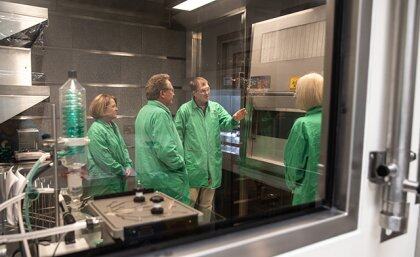In one of the world’s first plastics contamination-controlled laboratories, University of Queensland researchers have begun testing blood and tissue samples to develop ways to detect and measure nanoplastics in the human body.


A partnership between UQ and Minderoo Foundation, the Minderoo Centre – Plastics and Human Health will enable world-leading research using this unique lab, state-of-the-art equipment and specific techniques to measure nanoplastics in samples.
Minderoo Foundation Chair, Dr Andrew Forrest AO, said until now, researchers have not been able to accurately measure plastic particles at this scale to determine whether fragmented plastics and plastic-associated chemicals pose a human health risk.
“As plastics are found everywhere – even in the lab – we joined forces with UQ to undertake the ambitious project of designing and building a lab with some of the lowest plastic contamination in the world,” Dr Forrest said.
“Extensive testing of construction materials including paint, floor coverings and adhesives was conducted and as most of these materials contained plastics or plastic chemicals that can leach into the lab, it was built almost entirely out of welded stainless steel.
“UQ’s world-leading researchers were carefully selected to lead this research as experts in the techniques to measure the mass of very small concentrations of different molecules within a sample, to conclusively detect and measure plastics in human tissue and fluids.”
The team from UQ’s Queensland Alliance for Environmental Health Sciences wear brightly coloured, 100 per cent cotton scrubs made specifically for work carried out in the clean lab to minimise fibre shedding from standard lab coats and to ensure any fibres are easily identified.
QAEHS Director, Professor Kevin Thomas, said researchers were yet to understand whether nanoplastic particles and plastics smaller than 10 micrometres stayed in the body, rather than passing safely through the gut.
“We know that humans are exposed to plastics daily, but we don’t know if nanoplastics are in our urine, body and brain and if they do harm,” Professor Thomas said.
“Our team has been working tirelessly to develop methods that are sufficiently sensitive and robust to give us clear data to ensure plastic hasn’t entered the sample from the external environment.
“For example, if we’re working on a tissue sample in an open lab where plastics and additives are present in the air, it could become contaminated during testing.
“Samples from the Sydney Brain Bank are transferred to the lab to test for plastics such as polyethylene, polypropylene, PVC, and additives including phthalates and bisphenols, all found in commonly used products.
“After this first phase of research is complete, we can then start to measure chemicals and plastics within humans accurately so we can determine whether nanoplastic particles are in humans or not and get more accurate measures of plastic chemicals.”
The UQ-Minderoo research team expects to release their first findings by the end of the year and will then actively seek collaborations with other globally leading institutions working on similar missions around the world.






































